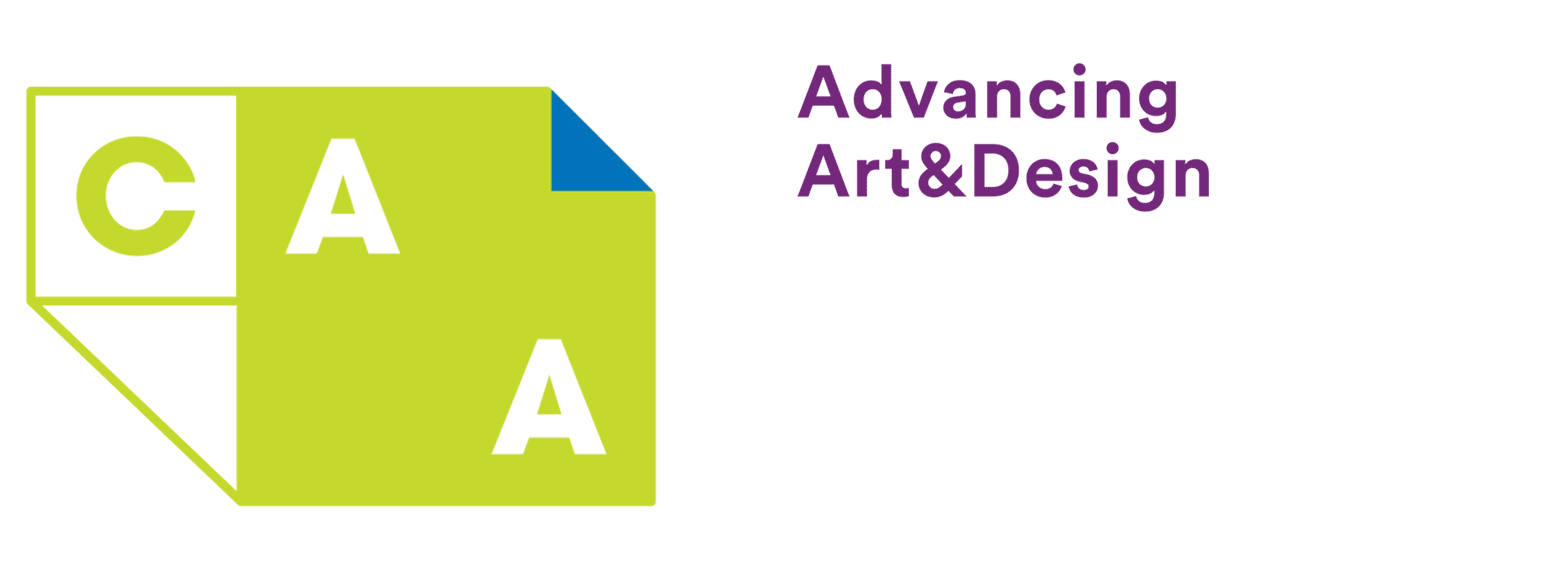CAA News Today
New in caa.reviews
posted by CAA — September 23, 2016
Alison C. Fleming reads Federico Barocci and the Oratorians: Corporate Patronage and Style in the Counter-Reformation by Ian F. Verstegen. The book “efficiently tackles the subject” of “the interior decoration of the Chiesa Nuova in Rome,” with a focus on Federico Barocci “and how his style corresponded so well to the tenets of the Oratorians that they repeatedly sought his paintings.” Read the full review at caa.reviews.
Claudia Swan reviews Benjamin Schmidt’s Inventing Exoticism: Geography, Globalism, and Europe’s Early Modern World. Merging historical and art-historical elements, this “formidable study” examines artworks and luxury goods “produced in Dutch ateliers between 1670 and 1730 under the rubric of ‘exotic geography,’” which the author views as “a new rhetorical and artistic mode.” Read the full review at caa.reviews.
Carol Damian discusses two books centered on the questions of what is a Latino and what is Latino art: Thirteen Way of Looking at Latino Art, by Ilan Stavans and Jorge J. E. Gracia, and Our America: The Latino Presence in American Art, an exhibition catalogue from the Smithsonian American Art Museum. Both books evidence how “the entire Latino issue is a construct, complicated, and imperfect” and “make valuable contributions to this ongoing discussion.” Read the full review at caa.reviews.
Caa.reviews publishes over 150 reviews each year. Founded in 1998, the site publishes timely scholarly and critical reviews of studies and projects in all areas and periods of art history, visual studies, and the fine arts, providing peer review for the disciplines served by the College Art Association. Publications and projects reviewed include books, articles, exhibitions, conferences, digital scholarship, and other works as appropriate. Read more reviews at caa.reviews.
Practice Your Interviewing Technique at the New York Conference
posted by CAA — September 22, 2016
In a competitive job market, everyone could use the opportunity to get feedback on interviewing and presentation. Take advantage of this opportunity to have a twenty-minute interview/mentoring session from a seasoned professional.
Students and emerging professionals have the opportunity to sign up for a twenty-minute practice interview at the 2017 Annual Conference in New York. Organized by the Student and Emerging Professionals Committee, the Mock Interview Sessions give participants the chance to practice their interview skills one on one with a seasoned professional, improve their effectiveness during interviews, and hone their elevator speech. Interviewers also provide candid feedback on application packets. Mock Interview Sessions are offered free of charge, but you must be a CAA member to participate. Sessions are filled by appointment only and scheduled within the SEPC Lounge for the following times:
Thursday, February 16: 11:30 AM–1:30 PM
Thursday, February 16: 3:00–5:00 PM
Friday, February 17: 9:00–11:00 AM
Friday, February 17: 2:00–4:00 PM
Conference registration, while encouraged, is not necessary to participate. To apply, fill out the Google Registration Form. You may enroll in one twenty-minute session. The deadline to register is February 6, 2017. You will be notified of your appointment day and time by email. Please bring your application packet, including cover letter, CV, and other materials related to jobs in your field. The Student and Emerging Professionals Committee will make every effort to accommodate all applicants; however, space is limited. There will be VERY limited registration onsite. If you have any questions, please email the Student and Emerging Professionals Committee.
News from the Art and Academic Worlds
posted by Christopher Howard — September 21, 2016
Each week CAA News summarizes eight articles, published around the web, that CAA members may find interesting and useful in their professional and creative lives.
Chicago Professors Fire Back
Last week more than 150 faculty members at the University of Chicago published an open letter to freshmen in which they take a strikingly different approach from the official communication sent by a Chicago dean. Safe spaces and trigger warnings, the letter said, are legitimate topics for discussion and reflect the real needs of many students. (Read more from Inside Higher Ed.)
On Art-Making after Tragedy
Public figures and Facebook users post responses, visual or verbal, immediately after tragedies and disasters occur. These easily created and intrinsically shareable responses raise important questions: Is this art created for social media? Is it created so quickly that its quality suffers? Is there something disingenuous about art making under such forced and mediated circumstances? (Read more from the Creators Project.)
Bill to Shield International Art Loans Gains in Senate
Legislation to safeguard international art loans will be taken up by the full Senate after years of criticism and complaints that the bill amounts to protection for plundered works. Last week the Senate Judiciary Committee, with bipartisan support, approved the Foreign Cultural Exchange Jurisdictional Immunity Clarification Act, which would extend added protections to shield works from seizure while on loan for exhibitions in the United States. (Read more from the New York Times.)
Public Opinion on Higher Education Is Waning
Americans are increasingly uncertain about the necessity of college for success in the workforce, according to Public Agenda’s recent survey, funded by the Kresge Foundation. For example, just 42 percent of Americans say college is necessary for workforce success, a 13 percent drop from 2009. (Read more from Public Agenda.)
Strategies to Maintain Focus while Writing Your Dissertation
Today, the internet and Google and social media are flashier and more distracting than ever before. Our professional and personal lives are strewn with interruptions as smart phones enable us to take our distractions with us wherever we go. This makes it incredibly challenging to maintain enough focus to write a book-length dissertation. (Read more from GradHacker.)
Is the Future of Fine Art in Hollywood’s Hands?
We might consider both Wes Anderson and Rashid Johnson to be artists, but traditionally the business dealings of a Hollywood director are handled by a mélange of agents, whereas the career of a fine artist is often managed by gallerists, dealers, and collectors. Josh Roth of United Talent Agency, however, wants to shake up any boundaries between Hollywood and the white cube. (Read more from Vice.)
On Not Reading
The activity of nonreading is something that scholars rarely discuss. When they—or others whose identities are bound up with books—do so, the discussions tend to have a shamefaced quality. Blame “cultural capital”—the sense of superiority associated with laying claim to books that mark one’s high social status. (Read more from the Chronicle Review.)
Is More Recognition the Key to Peer-Review Success?
Two contrasting concepts for peer reviewers are recognition and credit. Credit implies that a benefit is being given. Recognition may lead to a benefit but only passively. The importance of recognition is that others see the effort, and any benefit is happenstance. (Read more from the Scholarly Kitchen.)
Receive Career Advice or Feedback on Your Art
posted by CAA — September 20, 2016
 An interview at the 2016 Annual Conference in Washington, DC (photograph by Bradley Marks)
An interview at the 2016 Annual Conference in Washington, DC (photograph by Bradley Marks)CAA is committed to supporting and advancing the careers of professionals in the visual arts. As a CAA member, you have free access to a diverse range of mentors at Career Services during the 105th Annual Conference, taking place February 15–18, 2017, in New York.
All emerging, midcareer, and even advanced art professionals can benefit from one-on-one discussions with dedicated mentors about artists’ portfolios, career-management skills, and professional strategies. You may enroll in either the Artists’ Portfolio Review or Career Development Mentoring. Participants are chosen by a lottery of applications received by the deadline; all applicants are notified of their scheduled date and time slot via email in January 2017. Conference registration, while encouraged, is not necessary to participate; appointments are offered free of charge. Deadline: December 16, 2016.
Artists’ Portfolio Review
The Artists’ Portfolio Review offers CAA members the opportunity to have images of their work reviewed by artists, critics, curators, and educators in personal twenty-minute consultations. Whenever possible, CAA matches artists and mentors based on medium or discipline. You must bring a charged battery-powered laptop or hard copy of your portfolio to review your work. Sessions are filled by appointment only and scheduled for 8:30 AM–noon and 1:30–5:00 PM each day.
To apply, complete and submit the Artists’ Portfolio Review Enrollment Form. Contact Katie Apsey, CAA manager of programs, if you have any questions. Deadline: December 16, 2016.
Career Development Mentoring
Artists, art historians, art educators, and museum professionals at all stages of their careers may apply for one-on-one consultations with veterans in their fields. Through personal twenty-minute consultations, Career Development Mentoring offers a unique opportunity for participants to receive candid advice on how to conduct a thorough job search; present cover letters, CVs, and digital images; and prepare for interviews. Whenever possible, CAA matches participants and mentors based on their career area or discipline. You must bring your résumé or CV, your other job-search materials, and your specific career goals to discuss during these appointments. Sessions are filled by appointment only and scheduled for 8:30 AM–noon and 1:30–5:00 PM each day.
To apply, complete and submit the Career Development Mentoring Enrollment Form. Contact Katie Apsey, CAA manager of programs, if you have any questions. Deadline: December 16, 2016.
New in caa.reviews
posted by CAA — September 16, 2016
Annie Borneuf reviews Kurt Schwitters: Space, Image, and Exile by Megan R. Luke. This “compelling study” of the German artist’s “largely neglected works of the 1930s and 1940s” draws on unpublished archival material to demonstrate how the artist arrived “at a new sculptural theory of space that pivots on the interchange between work and beholder.” Read the full review at caa.reviews.
Trevor Stark discusses the Museum of Modern Art’s first digital-only publication, Picasso: The Making of Cubism, 1912–1914. The volume focuses on “the artist’s use of unorthodox materials and his development of new and still little-understood techniques for manipulating them,” and the “interactive hyperlink architecture” within the book opens up new possibilities for encountering Picasso’s work. Read the full review at caa.reviews.
Amy R. Bloch reads Stefanie Solum’s Women, Patronage, and Salvation in Renaissance Florence: Lucrezia Tornabuoni and the Chapel of the Medici Palace. In this “stimulating book,” the author asks “whether or not laywomen commissioned significant paintings, sculptures, or buildings in the city during the fifteenth century” by focusing on a Fra Filippo Lippi altarpiece possibly commissioned by Lucrezia Tornabuoni. Read the full review at caa.reviews.
Caa.reviews publishes over 150 reviews each year. Founded in 1998, the site publishes timely scholarly and critical reviews of studies and projects in all areas and periods of art history, visual studies, and the fine arts, providing peer review for the disciplines served by the College Art Association. Publications and projects reviewed include books, articles, exhibitions, conferences, digital scholarship, and other works as appropriate. Read more reviews at caa.reviews.
Work at the 2017 Conference
posted by CAA — September 15, 2016
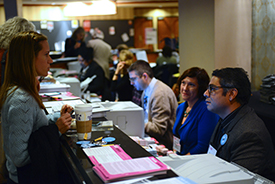 CAA members work with CAA staff in the registration booths at the 2016 Annual Conference in Washington, DC (photograph by Bradley Marks)
CAA members work with CAA staff in the registration booths at the 2016 Annual Conference in Washington, DC (photograph by Bradley Marks)Working as a room monitor at CAA’s 105th Annual Conference, taking place February 15–18, 2017, in New York, is a great way to save on conference expenses. CAA encourages students, emerging professionals, and any interested members—especially those in the New York City area—to apply for service.
Session Room Monitors
CAA seeks members to work as room monitors for all session rooms, Career Services rooms, and various conference events between Wednesday, February 15, 2017, and Saturday, February 18, 2017. Room monitors are responsible for monitoring conference badge and ticket adherence at the doors of session rooms, recording session attendance and collecting tickets, monitoring the capacity of session rooms, aiding the communication between session chairs and the onsite audiovisual specialists, checking in conference attendees with mentoring or portfolio-review appointments, and/or facilitating the work of the career-development mentors.
Successful applicants will be friendly, familiar with digital projectors and both Mac and PC laptops, communicative, and able to problem-solve quickly in the hectic conference environment. To apply, please send the following three items to Katie Apsey, CAA manager of programs, by December 16, 2016[DEADLINE EXTENDED!] JANUARY 9, 2017:
- One-page résumé
- Brief letter of interest including your CAA Member ID# and preferred days for scheduling
- An application form
Chosen applicants will be paid $12 per hour and receive full complimentary registration to the conference. Selected room monitors will be required to work a minimum of twenty hours over the four days of the conference, but may work up to thirty-two hours. All people hired for the conference must also attend a one-hour (paid) training meeting on Tuesday night, February 14, 2017.
All candidates must be US citizens or permanent US residents and able to fill out a W-9 employment form.
CAA membership is encouraged but not required. Students should check to see if their schools and universities are CAA institutional members, because institutional membership now includes the benefit of specially discounted student memberships for individuals.
Please contact Katie Apsey, CAA manager of programs, at kapsey@collegeart.org or 212-392-4405 with any questions.
News from the Art and Academic Worlds
posted by Christopher Howard — September 14, 2016
Each week CAA News summarizes eight articles, published around the web, that CAA members may find interesting and useful in their professional and creative lives.
The Most Relevant Art Today Is Taking Place outside the Art World
The central claim in Michael J. Lewis’s essay on the demise of art-as-culture is that “while the fine arts can survive a hostile or ignorant public, or even a fanatically prudish one, they cannot long survive an indifferent one.” The argument, however, ignores both the artists who have been historically marginalized from galleries and museums and the artists who are taking their practices outside those places. (Read more from Artsy.)
Art Demystified: The Gallery Breakdown
The art gallery remains one of the most important pillars of the art world today. It is where artists are first introduced and their careers are launched, and where the discourse is started. But what goes on behind the heavy doors of these often secretive empires? And what are the roles of those who work there? (Read more from Artnet News.)
President Obama’s Arts Focus Was National, Not Local
It should come as no surprise that where the arts were concerned, the Obamas didn’t just ignore the Pennsylvania Avenue playbook—they wrote their own script. They established dynamic programs and raised considerable money for arts initiatives. They also sometimes drifted away from the traditions of the past, which could leave locals frustrated and impatient. (Read more from the Chicago Tribune.)
Balancing the Books at Yale University Press in London
A letter signed by over 290 academics, curators, and writers expressed a “sense of shock at the restructuring of Yale University Press in London, particularly as it affects the renowned art books department.” Having learned that two commissioning editors were to be made redundant, the signatories asked for reassurance about Yale’s commitment to scholarly art publishing and for the rationale for the changes. (Read more from Apollo.)
Publish or Be Damned
The London office of Yale University Press has been a leading publisher of art history in the English language. When we heard of a new book planned by a leading scholar in the field, we expected to learn that Yale had pledged to publish it. When a bright graduate finished his or her dissertation, we hoped that Yale would publish it. (Read more from the Burlington Magazine.)
How Much Does Publishing Cost?
Whenever someone talks about the cost of publishing, the conversation seems to take place in a vacuum. Step inside a publishing company and ask this question: Where is the greatest amount of energy expended? The answer is in finding the best authors. Publishing, in other words, is about the relentless pursuit of the best content for a particular program. (Read more from the Scholarly Kitchen.)
Why the Hammer Museum’s New Free Digital Archives Are a Game Changer
Museum archives are historically places that draw only the most dedicated researchers to poke through boxes of files, trays of objects, and piles of ephemera generated by exhibitions. But the Hammer Museum is aiming to change the way museum archives are accessed and organized. (Read more from the Los Angeles Times.)
Valuing Intellectual Property in an AIA World
Whether one celebrates or decries the fifth anniversary of the America Invents Act, this much is clear: the law has had a dramatic impact on the value of US patents and, in turn, the broader US economy. A cloud of uncertainty hanging over patents has depressed their value and may have broader ramifications that are yet to be seen. (Read more from IP Watchdog.)
Become a Mentor or Reviewer for the 2017 Conference
posted by CAA — September 13, 2016
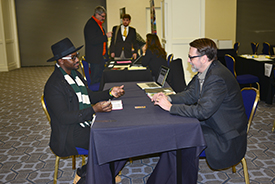 An interview at the 2016 Annual Conference in Washington, DC (photograph by Bradley Marks)
An interview at the 2016 Annual Conference in Washington, DC (photograph by Bradley Marks)For the 2017 Annual Conference in New York, CAA seeks established professionals in the visual arts to volunteer as mentors for two Career Services programs: Artists’ Portfolio Review and Career Development Mentoring. Participating as a mentor is an excellent way to serve the field and to assist the professional growth of the next generation of artists and scholars. Art historians, studio artists, critics, museum educators, and curators are especially requested by mentees. All mentors and reviewers must demonstrate significant experience in their fields.
Artists’ Portfolio Reviewers
CAA seeks artists, critics, curators, and educators to serve as reviewers for the Artists’ Portfolio Review. In this program, mentors review and provide feedback on digital images of work by artist members in personal twenty-minute consultations. Whenever possible, CAA matches artists and mentors based on medium or discipline. Mentors provide an important service to artists, enabling them to receive professional criticism of their work.
Interested candidates must be current CAA members with experience mentoring or advising and be prepared to give between four and nine successive twenty-minute critiques in a three-hour period. Reviewing shifts may occur between Wednesday, February 15, and Saturday, February 18, 2017, from 8:30 AM to noon and from 1:30 to 5:00 PM each day. Conference registration, while encouraged, is not required to be a reviewer. Preference will be given to reviewers who can serve multiple shifts or multiple days
Please send your CV and a brief letter of interest (outlining your specialty or field and your scheduling availability during the conference) to Katie Apsey, CAA manager of programs. Deadline: December 2, 2016.
Career Development Mentors
CAA seeks mentors from all areas of studio art, art history, art education, film and video, graphic design, the museum professions, and other related fields to serve as mentors for Career Development Mentoring. In this program, mentors give valuable advice to emerging and midcareer professionals, reviewing cover letters, CVs, digital images, and other pertinent job-search materials in personal twenty-minute consultations. Whenever possible, CAA matches participants and mentors based on medium or discipline.
Interested candidates must be current CAA members with experience mentoring or advising and be prepared to give between four and nine successive twenty-minute critiques in a three-hour period. Reviewing shifts may occur between Wednesday, February 15, and Saturday, February 18, 2017, from 8:30 AM to noon and from 1:30 to 5:00 PM each day. Conference registration, while encouraged, is not required to be a mentor. Preference will be given to mentors able to serve multiple shifts or multiple days.
Please send your CV and a brief letter of interest (outlining your specialty or field and your scheduling availability during the conference) to Katie Apsey, CAA manager of programs. Deadline: December 2, 2016.
Career Development Mentoring is not intended as a screening process by institutions seeking new hires. CAA does not accept applications from individuals whose departments are conducting a faculty search in the field in which they are mentoring. Mentors should not be attending the conference as candidates for positions in the same field in which mentees may be applying.
New and Forthcoming in CAA’s Journals
posted by CAA — September 12, 2016
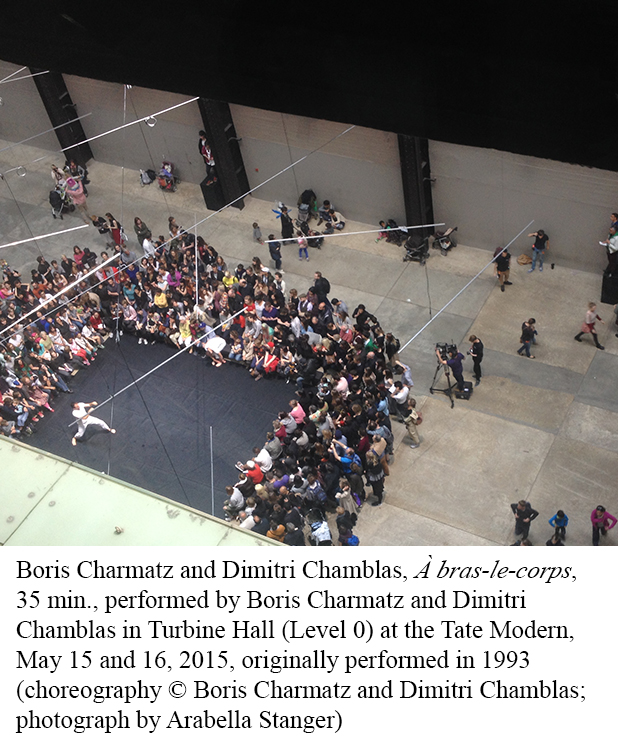 caa.reviews
caa.reviews
Boris Charmatz’s If Tate Modern Was Musée de la Danse? (May 15–16, 2015) is the focus of a new multimedia review on the Scalar platform, If caa.reviews were performance.reviews?. Organized by Juliet Bellow, the project includes an introduction by Bellow, and three reviews of the performances at the Tate Modern by Arabella Stanger, Nicole Zee, and Tamara Tomic-Vajagic. The review presents the complexities of Charmatz’s transformation of the Tate Modern into a museum of dance for two days and features an interactive map showing where the performances occurred in the Tate Modern, in addition to videos and still images. Charmatz’s project challenges conceptions of museums as institutional spaces and incorporates audience participation and “unauthorized” performances. This review is part of a new caa.reviews initiative to review time-based media works.
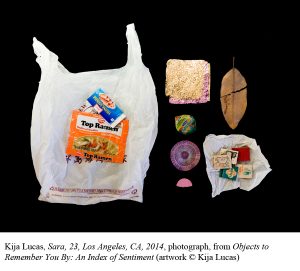 Art Journal Open
Art Journal Open
Art Journal Open this summer launched a new cluster of conversations featuring artist residencies, with artists who have participated in residencies interviewed by those who organize these programs. Through the conversations, Art Journal Open examines how residencies operate logistically and conceptually, and how they contribute to creative production. Conversations published in the series include Caitlin Masley-Chalet of Guttenberg Arts (Guttenberg, NJ) with artist Diana Shpungin, Vanessa Kauffman of Headlands Center for the Arts (Sausalito, CA) with artist Patricia Fernández Carcedo, and Amy Cancelmo of Root Division (San Francisco, CA) with artist Kija Lucas.
Earlier this summer, Art Journal Open published the third of a three-part series on appropriation as an artistic strategy: “Knight’s Heritage: Karl Haendel and the Legacy of Appropriation, Episode Three, 2013” by Natilee Harren, with a response by Nate Harrison. Recent features also include a review of Wetware: Art, Agency, Animation (Beall Center for Art + Technology, University of California, Irvine, February 6–May 7, 2016) by Charissa Terranova, and “Humans Have Been Human for So Long,” a dialogue between artist Shana Lutker and curator Mika Yoshitake on Lutker’s exhibition Shana Lutker: Le “NEW” Monocle, Chapters 1–3 at the Hirshhorn Museum and Sculpture Garden in Washington, DC (October 27, 2015–February 16, 2016).
Art Journal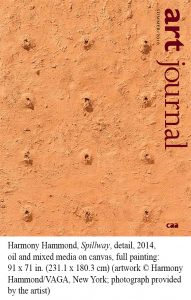
The forthcoming Fall 2016 Art Journal features a project by the artist Penelope Vlassopoulou, whose source material is the phrases and drawings carved in underground cells by detainees during the Nazi occupation of Greece. In other feature articles, Mario Merz’s fascination with the Fibonacci series is the cruz of Elizabeth Mangini’s examination of works created within the intellectual and political ferment of 1960s Italy, and Emily Hage rethinks Romare Bearden’s historical and political position in relation to the dense collages he made for the covers of Time and Fortune. The Reviews section includes Eve Meltzer’s account of the film Eva Hesse and reviews of books by Thomas Crow, Claire Robins, and Joan Kee. An annotated bibliography by Roger F. Malina, the astrophysicist who also serves as executive editor of Leonardo Publications/MIT Press, explores the highly productive intersections of art and science.
Recently published in the Summer 2016 Art Journal is a project by the renowned artist Harmony Hammond. The covers of the journal were given a waxy coating to convey the nature of her intensely tactile paintings and prints, featured in a twenty-page portfolio. In the features, Amanda Jane Graham takes a close look at the interweaving of domestic and performing spaces in Trisha Brown’s 1975 dance Locus; Mechtild Widrich investigates the effects on the urban fabric of the new/old National Gallery of Singapore, created from a colonial-era court building; and Dan Adler traces the idea of an all-pervasive Apparatus in 1980s and 1990s works by the German photographer Thomas Ruff. The Reviews section begins with Chris Taylor’s examination of the film Troublemakers: The Story of Land Art. Other reviews examine a new book by Chika Okeke-Agulu and the exhibition and catalogue Hippie Modernism. An annotated bibliography by Audra Wolowiec explores the poetics of sound and language.
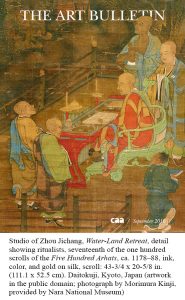 The Art Bulletin
The Art Bulletin
The cover of the September 2016 issue of The Art Bulletin depicts Buddhist monks evoking ghosts in a nocturnal ceremony; the large detail from a polychrome silk scroll accompanies Phillip E. Bloom’s essay on twelfth-century Chinese paintings of Buddhist rituals. In other essays featured in the September issue, Judy Sund reconsiders nineteenth-century perceptions of Watteau’s Pierrot character as forlorn, Christine I. Ho contextualizes a brush-and-ink painting created by a collective in the early People’s Republic of China, and James Nisbet surveys intersections of global politics and imaging in the site-specific art of Walter De Maria. In his “Whither Art History?” essay, Bárbaro Martínez-Ruiz explores Kongo visual and cultural practices in contemporary art.
The Reviews section, with a theme of “Urban Images, Memories, and Fragments,” includes four reviews of recent books on the cultures of fifth-century BCE Athens, seven Dutch cities from 1200 to 1700, early modern Rome, and Mexico City in light of Aztec civilization.
Taylor & Francis Online
In addition to their print subscription(s), CAA members receive online access to current and back issues of Art Journal and The Art Bulletin. Taylor & Francis, CAA’s publishing partner, also provides complimentary online access to Word and Image, Digital Creativity, and Public Art Dialogue for CAA members. To access these journals, please log into your account at collegeart.org and click the link to the CAA Online Publications Platform on Taylor & Francis Online.
CAA Connect is Live
posted by CAA — September 12, 2016
 We are pleased to announce the launch of CAA Connect, our new digital discussion platform and resource library. CAA Connect is a user-friendly social hub offering discussion communities with topic threads, the ability to post and share many forms of media, and the opportunity for collaboration across disciplines. We hope that many of the cross-disciplinary and scholarly conversations that occur at the Annual Conference each year continue on CAA Connect. Registration will open next week for the 105th Annual Conference in New York, February 15-18, 2017.
We are pleased to announce the launch of CAA Connect, our new digital discussion platform and resource library. CAA Connect is a user-friendly social hub offering discussion communities with topic threads, the ability to post and share many forms of media, and the opportunity for collaboration across disciplines. We hope that many of the cross-disciplinary and scholarly conversations that occur at the Annual Conference each year continue on CAA Connect. Registration will open next week for the 105th Annual Conference in New York, February 15-18, 2017.
We are launching CAA Connect with a series of starter communities that address important issues for visual arts professionals. Below is a list of the starter communities that are accessible for all CAA members and the names of those who have offered to facilitate discussion in the communities.
To contribute to community discussions, please log in to CAA Connect (click “Log In” in upper right of home page) using your existing CAA Account credentials. If this is your first time logging in to CAA Connect, you will be prompted to accept CAA Connect’s Community Guidelines before continuing. Please review the CAA Connect tutorials for a quick overview of the platform. Once you have signed in to CAA Connect or your CAA account, you will automatically be logged in to both sites and you will be able to switch back and forth without logging in again. The CAA member directory will now reside on CAA Connect. By default all members are included in the searchable directory. To learn more about how to be excluded from the directory, read the “Logging in and Profile Setup” tutorial in the Welcome to CAA Connect community.
Starter Communities
Museums
Anuradha Vikram, Director of Residency Programs at 18th Street Arts Center, Santa Monica, California
Anne Goodyear, Co-Director of the Bowdoin College Museum of Art
CAA Annual Conference
Tiffany Dugan, Director of Programs at College Art Association
Judith Rodenbeck, Annual Conference Program Chair and Associate Professor at University of California at Riverside
Fair Use
Patricia Aufderheide, University Professor, School of Communication, American University and Co-Principal Investigator on the CAA Fair Use Initiative
Peter Jaszi, Professor of Law, Washington College of Law, American University, and Co-Principal Investigator on the CAA Fair Use Initiative
Janet Landay, Program Manager, Fair Use Initiative and Project Director, CAA-Getty International Program
Latin American Art
Michele Greet, Associate Professor of Art History at George Mason University
Elisa Mandell, Associate Professor of Art History at California State University, Fullerton
Most importantly, we want CAA Connect to grow with our members, to be influenced by the work and focus of our members. Look for a survey in early October asking you what communities and types of content you’d like to see on CAA Connect. We can only build the right kind of platform to push forward the visual arts with your help.
Please contact us if you have any questions at all.
We look forward to the discussions!
